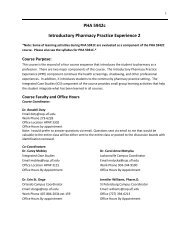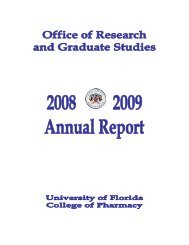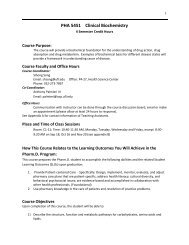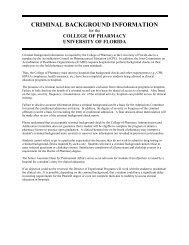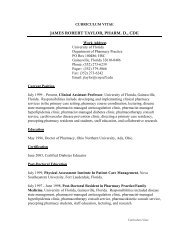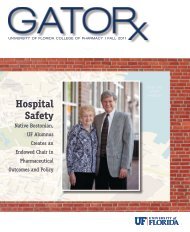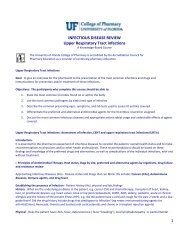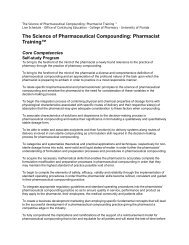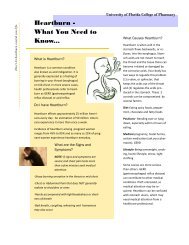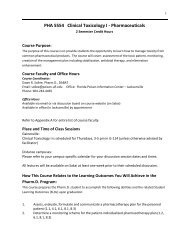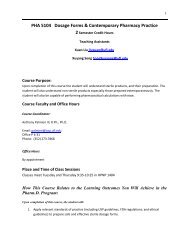Module 3: The Drug Regimen Review - College of Pharmacy ...
Module 3: The Drug Regimen Review - College of Pharmacy ...
Module 3: The Drug Regimen Review - College of Pharmacy ...
Create successful ePaper yourself
Turn your PDF publications into a flip-book with our unique Google optimized e-Paper software.
Intent: §483.25<br />
<strong>The</strong> facility must ensure that the resident obtains optimal improvement or does not deteriorate within the limits<br />
<strong>of</strong> a resident’s right to refuse treatment, and within the limits <strong>of</strong> recognized pathology and the normal aging<br />
process.<br />
NOTE: Use guidance at F309 for review <strong>of</strong> quality <strong>of</strong> care not specifically covered by 42<br />
CFR 483.25 (a)-(m). Tag F309 includes, but is not limited to, care such as end-<strong>of</strong>-life,<br />
diabetes, renal disease, fractures, congestive heart failure, non-pressure related skin ulcers,<br />
pain, or fecal impaction.<br />
Assessment<br />
<strong>Review</strong> information such as orders, medication administration records, multi-disciplinary<br />
progress notes, the RAI/MDS, and any specific assessments that may have been completed.<br />
Determine if the information accurately and comprehensively reflects the resident’s<br />
condition. In considering the appropriateness <strong>of</strong> a facility’s response to the presence or<br />
progression <strong>of</strong> a condition/diagnosis, take into account the time needed to determine the<br />
effectiveness <strong>of</strong> treatment, and the facility’s efforts, where possible, to remove, modify, or<br />
stabilize the risk factors and underlying causal factors.<br />
Pharmacological interventions<br />
<strong>The</strong> interdisciplinary team (nurses, practitioner, pharmacists, etc.) is responsible for developing a pain<br />
management regimen that is specific to each resident who has pain or who has the potential for pain,<br />
such as during a treatment. <strong>The</strong> regimen considers factors such as the causes, location, and severity <strong>of</strong><br />
the pain, the potential benefits, risks and adverse consequences <strong>of</strong> medications; and the resident’s<br />
desired level <strong>of</strong> relief and tolerance for adverse consequences. <strong>The</strong> resident may accept partial pain<br />
relief in order to experience fewer significant adverse consequences (e.g., desire to stay alert instead <strong>of</strong><br />
experiencing drowsiness/confusion). <strong>The</strong> interdisciplinary team works with the resident to identify the<br />
most effective and acceptable route for the administration <strong>of</strong> analgesics, such as orally, topically, by<br />
injection, by infusion pump, and/or transdermally.<br />
It is important to follow a systematic approach for selecting medications and doses to treat pain.<br />
Developing an effective pain management regimen may require repeated attempts to identify the right<br />
interventions. General guidelines for choosing appropriate categories <strong>of</strong> medications in various<br />
situations are widely available. 23,24<br />
Factors influencing the selection and doses <strong>of</strong> medications include the resident’s medical condition,<br />
current medication regimen, nature, severity, and cause <strong>of</strong> the pain and the course <strong>of</strong> the illness.<br />
Analgesics may help manage pain; however, they <strong>of</strong>ten do not address the underlying cause <strong>of</strong> pain.<br />
Examples <strong>of</strong> different approaches may include, but are not limited to: administering lower doses <strong>of</strong><br />
medication initially and titrating the dose slowly upward, administering medications “around the<br />
clock” rather than “on demand” (PRN); or combining longer acting medications with PRN<br />
medications for breakthrough pain. Recurrent use <strong>of</strong> or repeated requests for PRN medications may<br />
indicate the need to reevaluate the situation, including the current medication regimen. Some clinical<br />
conditions or situations may require using several analgesics and/or adjuvant medications (e.g.,<br />
antidepressants or anticonvulsants) together. Documentation helps to clarify the<br />
50



